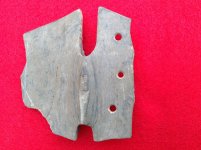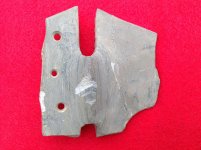georgia flatlander
Full Member
Last night I was looking at a few of my bannerstones, and as always marveled at their construction. I'm still up in the air as to their intended usage, mainly because of the different sizes and forms. In particular, what concerns me about the theory of bannerstones being used as atlatl weights is the diameter of the hole. All of mine are less than 1/2" in diameter, which doesn't conform to the expected dimensions of a functioning atlatl. It would require that the atlatl be less than 1/2" in diameter, and that it be perfectly round. Atlatl weights also give me some pause as to their intended usage due to a few factors, one being shape and the other being size. Atlatls are not new technology, and if the archaeological record is to be believed, the bow-and-arrow were only developed here somewhere in the neighborhood of 1200 years ago. That allows for thousands of years of atlatl (and atlatl weight) development and perfection. Given the ability of native stone workers, why would an atlatl weight not conform to the haft of the atlatl? For an item to be such an important part of their everyday life, it seems to ignore all reasoning to believe that a cylindrical atlatl weight was tied to a flat hafted atlatl, when just a little more effort would have contoured the weight perfectly. Given that the stone would last longer than the wood, it would make more sense that the natives would form the atlatl to meet the contours of the stone, and not the other way around.
I have seen flat pieces of stones with drilled holes that some call gorgets, and others call atlatl weights, and they would make more sense being an object that conforms to the atlatl.
If anyone has any insight, other than just arguing that it is so because it's the accepted theory, please expound. I just can't wrap my mind around the fact that they settled for trying to make a square peg fit a round hole, so to speak, when everything else they did was purposeful and engineered.
Thanks in advance.
I have seen flat pieces of stones with drilled holes that some call gorgets, and others call atlatl weights, and they would make more sense being an object that conforms to the atlatl.
If anyone has any insight, other than just arguing that it is so because it's the accepted theory, please expound. I just can't wrap my mind around the fact that they settled for trying to make a square peg fit a round hole, so to speak, when everything else they did was purposeful and engineered.
Thanks in advance.
Amazon Forum Fav 👍
Upvote
0



 Gary
Gary



